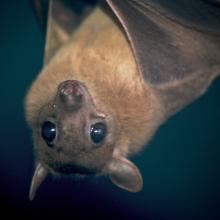Rousettus aegyptiacus

Conservation Status:
Least Concern
Range:
Northern Africa and the Middle East
Habitat:
Dense tropical forests, caves, rock crevices, human-made structures
Fruit bats are named for their preferred diet of soft, pulpy fruit like dates, peaches, and apples. Egyptian fruit bats eat between 50% to 150% of their body weight in fruit EVERY DAY.
Fruit bats can swoop in to get a mouthful of fruit, or they can hang directly on their food. Either way, they usually suck the juice from the fruit and drop the pulp on the ground. This makes fruit bats very important for seed dispersal in their natural environment because those fruit seeds will fall to the ground wherever the bat is.
Bats are mammals, and that means they have a few features in common with humans. They have hair, they give live birth, and they give milk to their babies. Birds don't do any of those things. Because bats are mammals they have some other big differences from birds.
For one thing, bats have a very different wing structure. Birds have bones in their wings that are like us flapping our whole arm at the shoulder. Bats have a very short upper arm and extremely long finger bones. The skin of their wings is stretched between their finger bones. If you look closely you'll see a hook on the top of each wing- those are their thumbs!
Another interesting feature of bat wings is that they are HUGE compared to a similarly sized bird. There's a few reasons for this. First, bats have solid bones that weigh more than bird bones, so they have to lift more mass than a bird does. Second, the bat's flexible wings give it huge amounts of mobility at the cost of flying efficiency. In fact, a bird can fly almost 30% further on the same amount of energy as a bat of similar size.
Bats are also different from birds in that they give live birth. The baby is born while the mother hangs upside down. Bats have unusually long gestation periods for their size- four whole months!- because the baby must be strong enough to hang on as soon as it's born. It hangs under the mother's wing drinking milk for about six weeks until it's too heavy to carry around during flight. At that point the mother leaves it behind on a branch and brings it food until it's old enough to forage on its own at about three months.
Egyptian fruit bats have an adaptation called echolocation, where they make high-frequency clicks using their tongue and listen carefully for echoes with their sensitive ears. This helps them visualize their environment and locate food. The sounds are too high for humans to hear. The echolocation clicks start out slowly but become more frequent as they approach an object. Echolocation is energetically expensive, so Egyptian fruit bats are one of the only types of fruit bat to use it. Contrary to the popular phrase "blind as a bat", these bats can also use their excellent vision and sense of smell to find fruit.
